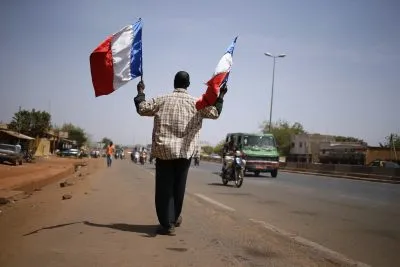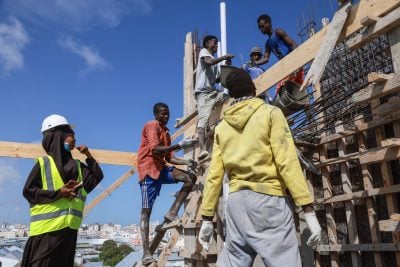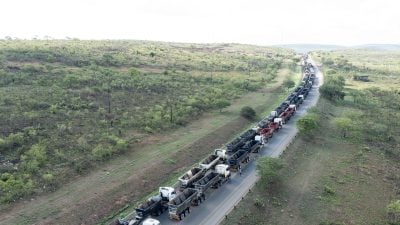The 2022 African Economic Outlook (AEO), the African Development Bank’s flagship publication released at the midpoint of last week’s Annual Meetings in Accra, can be summarised in six words: Growth, down. Inflation, up. Debt, stable.
Certainly, the headline messages make for grim reading. Africa has suffered terribly from the twin crises of Covid-19 and Russia’s invasion of Ukraine, while the escalating impacts of climate change – felt sooner and harder in Africa than anywhere else – chip constantly away at the continent’s productive capacity.
The year 2020 saw Africa slip into its first continental recession in over half a decade, and governments, needing to rapidly expand support to their ailing economies, were forced to incur massive amounts of debt that have stabilised, on average, at above 70% of GDP.
Then along came Putin, swinging a sledgehammer through global supplies of food, fuel and fertiliser, driving prices for these commodities into the stratosphere and forcing the millions of Africans that rely on them into severe cost-of-living stress.
These three factors – contraction, inflation and debt – have together jeopardised the rebuild that Africa commenced in 2021, and the AEO is frank in warning: “Africa’s growth outlook is highly uncertain, with risks tilting to the downside.”
But below this headline runs currents of complexity, and suggestions that Africa’s economic future is unambiguously grim risk neglecting the fine-grained analysis that the AEO provides. It worth looking a little closer, to see whether a more conditional, more illuminating – and perhaps, slightly rosier – picture can emerge.
African economies battered but resilient
It is true that global upheavals such as Russia’s invasion of Ukraine and widespread monetary tightening have shaved off some of Africa’s post-Covid gains.
The AEO predicts real GDP growth to decelerate to 4.1% in 2022. But it is worth remembering that prior to these shifts, Africa had one of the largest and most robust recoveries of any region on earth, with its 6.9% real gross GDP growth in 2021 eclipsing the European, North American, South American and world averages.
Even more telling is the manner in which this recovery was achieved. According to the AEO, the three major factors underpinning Africa’s bounce-back in 2021 were higher oil prices, the easing of Covid restrictions and strong domestic consumption and investment.
That two of these – governance in the case of Covid restrictions and domestic demand in the case of consumption and investment – originate on the continent itself, as opposed to volatile international commodity markets, bode well for the resumption of robust, stable growth once the latest round of shocks has filtered through.
Moreover, over 60% of this growth was generated by services, which in prior years had barely contributed more than a third. This suggests that Africa is beginning to shed its economic reliance on primary production, and is fast establishing a high-value, tertiary economy fit for the networked world of the 21st century.
Huge diversity in African countries’ growth performance
Africa is not a country. It is a continent made up of over 54 highly diverse states, covering 1.3bn people whose myriad economic activities together generate almost $3 trillion in annual GDP. The AEO takes African diversity seriously, and presents its analysis by country, region and economy type.
What we see is huge diversity in growth performance, with varied economic structures absorbing common shocks in different ways. Perhaps unsurprisingly, Africa’s oil exporters are projected to do best, even as countries such as South Sudan, Angola and Nigeria experience some of the highest inflation figures on the continent.
The largest economic rebound, however, was in tourism-dependent economies such as Mauritius, which were hit hardest by pandemic curbs on global mobility. From a 12% contraction in 2020, these economies are estimated to have returned to over 4% in 2021 and a projected, continent-wide high of almost 6% in 2022 as strong vaccination rollouts entice international travellers to return.
Regionally, too, new stories emerge. North Africa – buoyed largely by Libyan oil exports – experienced the largest regional economic turnaround, with estimated growth of 11.7% in 2021.
But East Africa, thanks to a combination of economic diversity, intra-regional trade, and governments’ willingness to spend large sums on productivity-enhancing investments such as infrastructure, was the only region that managed to avoid recession entirely across 2020-21.
This model may point to a more resilient future for Africa, as countries in other regions spy the benefits of non-reliance on any one particular product or class of exports for weathering unanticipated, exogenous economic shocks.
Tensions between development and climate policy
The 2022 AEO echoes the theme of the Annual Meetings at which it was launched. The subtitle – “Supporting Climate Resilience and a Just Energy Transition in Africa” – and the two chapters devoted to it reflect the urgency with which climate change has come to be viewed as the fundamental economic, development and policy problem on the continent.
The contents, however, provide the clearest depiction of a tension that was implicit throughout the meetings. On the one hand, Africa’s negligible historical emissions and urgent development imperative provide it with ample moral justification for the emulation of the rich world’s emission-intensive development model. As AfDB President Akinwumi Adesina is so fond of saying, “Africa cannot be poor in an environmentally sustainable manner.”
On the other hand, however, each additional unit of fossil fuel that is extracted and burned – whether in Europe, Australasia, North America or, if the AfDB has its way, in Africa – intensifies the extreme weather and inhospitable environmental conditions that are killing Africans and costing vast sums every single day.
Not to mention the radical technology, policy and market shifts that, in the words of Prof. Kevin Urama, Chief Economist of the AfDB and lead author of the AEO, “mean that continued investment in fossil fuel energy systems means risking asset stranding.”
The AEO sides with each at different times. “Africa must not be denied the carbon space to develop its economy,” it demands, before conceding that, because an “overreliance on cheap fossil fuels to drive industrialisation… comes with social, economic and environmental externalities”, “the “grow first, clean up later” principle is no longer tenable”.
Similarly, it argues in favour of gas as both a “transition fuel” and essential component of future African prosperity, before remarking that “while fossil-driven pathways have facilitated growth and prosperity in the past, this pathway to industrialisation is closing.”
These are live debates within the development, economic and environmental communities, and Africa – simultaneously the most resource-rich and climate-exposed region on earth – is at the fulcrum.
Africa’s economic future is not a simple story
The AEO, as the flagship product of one of Africa’s most dominant institutions, provides an invaluable insight into the forces and ideas that shape the lives of billions. Drilling down into simple narratives reveals that Africa’s economic, development and environmental futures are as complex, diverse and dynamic as the continent itself, and in many cases, are being negotiated in real time.
Want to continue reading? Subscribe today.
You've read all your free articles for this month! Subscribe now to enjoy full access to our content.
Digital Monthly
£8.00 / month
Receive full unlimited access to our articles, opinions, podcasts and more.
Digital Yearly
£70.00 / year
Our best value offer - save £26 and gain access to all of our digital content for an entire year!
 Sign in with Google
Sign in with Google 



